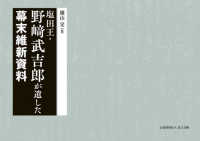Full Description
Stimulant drugs are widely used in the treatment of ADHD in children and adults. Hundreds of studies over the past 60 years have demonstrated their effectiveness in improving attention span, increasing impulse control, and reducing hyperactivity and restlessness. Despite widespread interest in these compounds, however, their mechanisms of action in the central nervous system have remained poorly understood. Recent advances in the basic and clinical neurosciences now afford the possibility of elucidating these mechanisms. The current volume is the first to bring this expanding knowledge to bear on the central question of why and how stimulants exert their therapeutic effects. The result is a careful, comprehensive, and insightful integration of material by well-known scientists that significantly advances our understanding of stimulant effects and charts a course for future research. Part I presents a comprehensive description of the clinical features of ADHD and the clinical repsonse to stimulants. Part II details the cortical and subcortical neuroanatomy and functional neurophysiology of dopamine and norepinephrine systems with respect to the regulation of attention, arousal, activity, and impulse control on the basis of animal studies. Part III is devoted to clinical research, including recent studies of neuroimaging, genetics, pharmacodynamic and pharmacokinetic properties of stimulants, effects on cognitive functions, neurophysiological effects in humans with and without ADHD and in non-human primates, and comparison of stimulants and non-stimulants in the treatment of ADHD. Part IV is a masterful synthesis that presents alternative models of stimulant drug action and generates key hypotheses for continued research. The volume will be of keen interest to researchers and clinicians in psychiatry, psychology, and neurology, neuroscientists studying stimulants, and those persuing development of new drugs to treat ADHD.
Contents
PART I: PHENOMENOLOGY; PART II: BASIC NEUROSCIENCE; PART III: CLINICAL NEUROSCIENCE; PART IV: INTEGRATION








